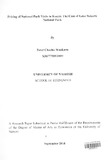| dc.description.abstract | This study undertook an analysis of factors determining recreational demand for Kenya's National Parks with Lake Nakuru National Park (LNNP) as a case study. This was conducted through a two step regression process culminating into development of a pricing strategy for the park. In the first step, count data models were used to estimate the demand function to LNNP for international and domestic visitors. The, main factors determining international visitation included: travel costs, age of respondent, education level, nature of the trip (either as a package or individual) and the size of the tour party accompanying the visitor. For the domestic visitors, visitation was determined by travel costs, personal income, age of the visitor, and occupation of the respondent.
In the second part, the count data models were used to predict the number of visitation as travel cost was varied with increase in the gate fee. This simulated data was used to obtain a second step regression and estimation of demand curves for LNNP by both the international and domestic visitors. The demand curves were inverted and used for a pricing strategy that could ensure that the prices are set in a way that fully recovers the cost of supplying the tourism product by LNNP.
The findings indicate that the current price set-up at LNNP of Ksh. 7,050 for international visitors and Ksh. 500 for domestic visitors was in fact cost recovery. However, there is greater scope to raise more revenue from an increase in entry fees. For international visitors, the study recommends that KWS could experiment with a price increase of between Ksh. 10,000 to Ksh. 50,000 per visitation. This price increase will yield total revenue of Ksh. 5.8 biIlion and still maintain high level of international visitation days (124,000). For domestic visitors, the revenue maximizing price is Ksh. 4,000.00 that yields total revenue of Ksh.350 million. However, KWS could experiment with prices of between Ksh. 1,000 and Ksh. 2,000 for domestic visitors and yield total revenue of between Ksh. 182 million and Ksh.293 miIlion from this group. A price increase to Ksh. 2,000 would reduce visitation from the current 87,294 to an estimated 65,000 which remains high for domestic visitation. | en_US |

